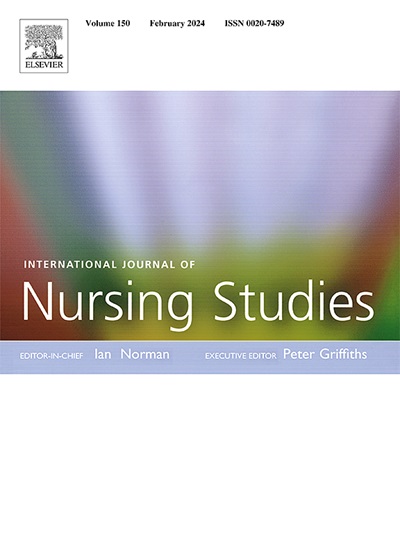Comparative analysis of the effectiveness of pharmacological and non-pharmacological interventions on arteriovenous fistula cannulation-related pain in patients receiving hemodialysis: A systematic review and network meta-analysis
IF 7.1
1区 医学
Q1 NURSING
引用次数: 0
Abstract
Background
Managing arteriovenous fistula cannulation pain in patients receiving hemodialysis is essential for ensuring patient comfort and promoting adherence to treatment. Various interventions have been proposed to alleviate this pain.
Objective
To evaluate the comparative effects of non-pharmacological and pharmacological interventions and to rank the best intervention options for cannulation-related pain.
Methods
A Systematic review and network meta-analysis were conducted. Five electronic English databases (Medline, CINAHL, EMBASE, Cochrane Trials, and Clinical trials.gov) were searched from inception until November 2023 to identify eligible randomized controlled trials. Screening, data abstraction, and quality assessment were performed by two independent reviewers. The Cochrane Collaboration risk of bias tool 2.0 was used to determine the risk of bias. Data were analyzed using RStudio with the netmeta package, employing a frequentist framework and random effects model.
Results
Twenty-four randomized controlled trials published between 2014 and 2023, involving 1704 participants, were included. The studies comprised 25 interventions, categorized into alternative/complementary therapies and local anesthetics. Compared to usual care, 11 interventions statistically significantly improved AVF cannulation pain: cryotherapy combine with visual distraction (SMD = 4.32, 95 % CI: 1.87, 6.77), visual distraction (SMD = 3.95, 95 % CI: 2.12, 5.77), lavender inhalation aromatherapy (SMD = 3.68, 95 % CI 2.63, 4.73), arnica ointment (SMD = 2.83, 95 % CI: 0.81, 4.85), auricular acupressure combine with compound lidocaine cream (SMD = 2.70, 95 % CI: 0.90, 4.51), lavender topical aromatherapy (SMD = 2.51, 95 % CI: 0.88, 4.14), lidocaine tape (SMD = 2.36, 95 % CI: 0.15, 4.57), cooling spray (SMD = 2.17, 95 % CI: 0.59, 3.76), EMLA cream 5 % (SMD = 1.80, 95 % CI: 0.48, 3.12), auditory distraction (SMD = 1.78, 95 % CI: 0.01, 3.55), and Hegu point acupressure (SMD = 1.52, 95 % CI: 0.04, 3.01). The P-scores and SUCRA rankings indicated that cryotherapy combined with visual distraction, visual distraction alone, and lavender inhalation aromatherapy were the top three effective interventions, respectively.
Conclusions
Non-pharmacological interventions, particularly cryotherapy combined with visual distraction, visual distraction alone, and lavender inhalation aromatherapy, were determined to be effective in reducing arteriovenous fistula cannulation-related pain in hemodialysis patients. Integrating these interventions into clinical practice can enhance patient comfort during hemodialysis procedures. Further research is needed to explore individualized approaches and assess the long-term efficacy of these interventions.
Registration
The review protocol was registered at PROSPERO (CRD42023475975).
药物和非药物干预对血液透析患者动静脉瘘插管相关疼痛的效果比较分析:系统综述和网络荟萃分析
背景:处理血液透析患者的动静脉瘘插管疼痛对于确保患者舒适和促进治疗依从性至关重要。人们提出了各种干预措施来减轻这种痛苦。目的评价非药物和药物干预对插管相关疼痛的比较效果,并对最佳干预方案进行排序。方法采用系统评价和网络meta分析。5个电子英文数据库(Medline, CINAHL, EMBASE, Cochrane Trials和Clinical Trials .gov)从成立到2023年11月进行检索,以确定符合条件的随机对照试验。筛选、数据提取和质量评估由两名独立的审稿人完成。使用Cochrane Collaboration的偏倚风险工具2.0来确定偏倚风险。数据分析使用RStudio和netmeta软件包,采用频率框架和随机效应模型。结果纳入2014 - 2023年间发表的24项随机对照试验,共1704名受试者。这些研究包括25项干预措施,分为替代/补充疗法和局部麻醉。与常规护理相比,11项干预措施有统计学意义上显著改善AVF插管疼痛:冷冻治疗联合视觉分散(SMD = 4.32, 95% CI: 1.87, 6.77)、视觉分散(SMD = 3.95, 95% CI: 2.12, 5.77)、薰衣草吸入芳香疗法(SMD = 3.68, 95% CI: 2.63, 4.73)、山金车膏(SMD = 2.83, 95% CI: 0.81, 4.85)、耳穴压联合复方利多卡因乳膏(SMD = 2.70, 95% CI: 0.90, 4.51)、薰衣草局部芳香疗法(SMD = 2.51, 95% CI: 95% CI: 0.90, 4.51)。0.88, 4.14)、利多卡因胶带(SMD = 2.36, 95% CI: 0.15, 4.57)、冷却喷雾(SMD = 2.17, 95% CI: 0.59, 3.76)、EMLA乳膏5% (SMD = 1.80, 95% CI: 0.48, 3.12)、听觉分散(SMD = 1.78, 95% CI: 0.01, 3.55)、合谷穴按压(SMD = 1.52, 95% CI: 0.04, 3.01)。p评分和SUCRA排名显示,冷冻联合视觉分散疗法、单独视觉分散疗法和薰衣草吸入芳香疗法分别是前三名的有效干预措施。结论非药物干预措施,特别是冷冻疗法联合视觉分散、单独视觉分散、薰衣草吸入芳香疗法可有效减少血液透析患者动静脉瘘插管相关疼痛。将这些干预措施纳入临床实践可以提高患者在血液透析过程中的舒适度。需要进一步的研究来探索个性化的方法并评估这些干预措施的长期疗效。该审查方案在PROSPERO注册(CRD42023475975)。
本文章由计算机程序翻译,如有差异,请以英文原文为准。
求助全文
约1分钟内获得全文
求助全文
来源期刊
CiteScore
15.00
自引率
2.50%
发文量
181
审稿时长
21 days
期刊介绍:
The International Journal of Nursing Studies (IJNS) is a highly respected journal that has been publishing original peer-reviewed articles since 1963. It provides a forum for original research and scholarship about health care delivery, organisation, management, workforce, policy, and research methods relevant to nursing, midwifery, and other health related professions. The journal aims to support evidence informed policy and practice by publishing research, systematic and other scholarly reviews, critical discussion, and commentary of the highest standard. The IJNS is indexed in major databases including PubMed, Medline, Thomson Reuters - Science Citation Index, Scopus, Thomson Reuters - Social Science Citation Index, CINAHL, and the BNI (British Nursing Index).

 求助内容:
求助内容: 应助结果提醒方式:
应助结果提醒方式:


